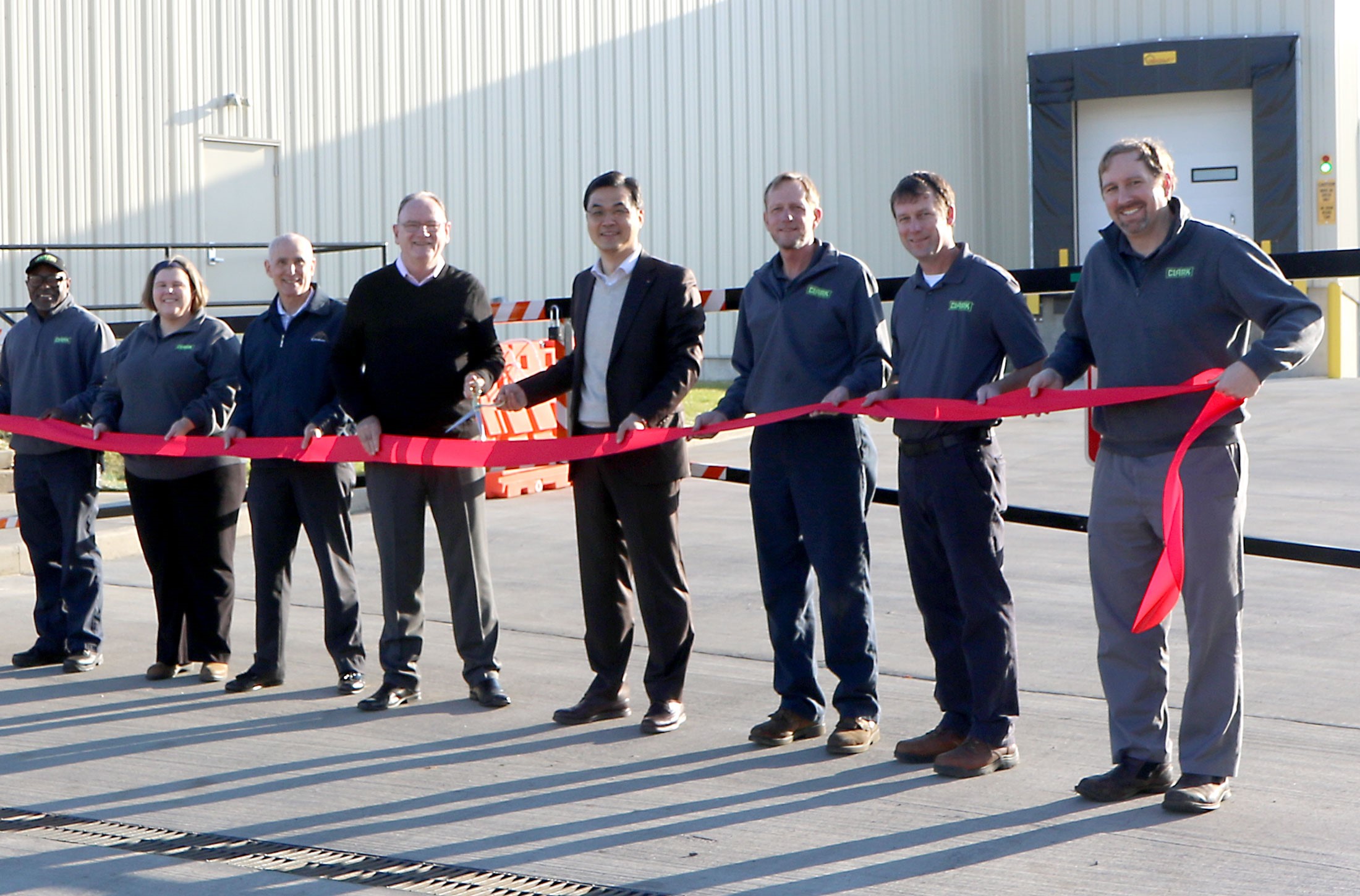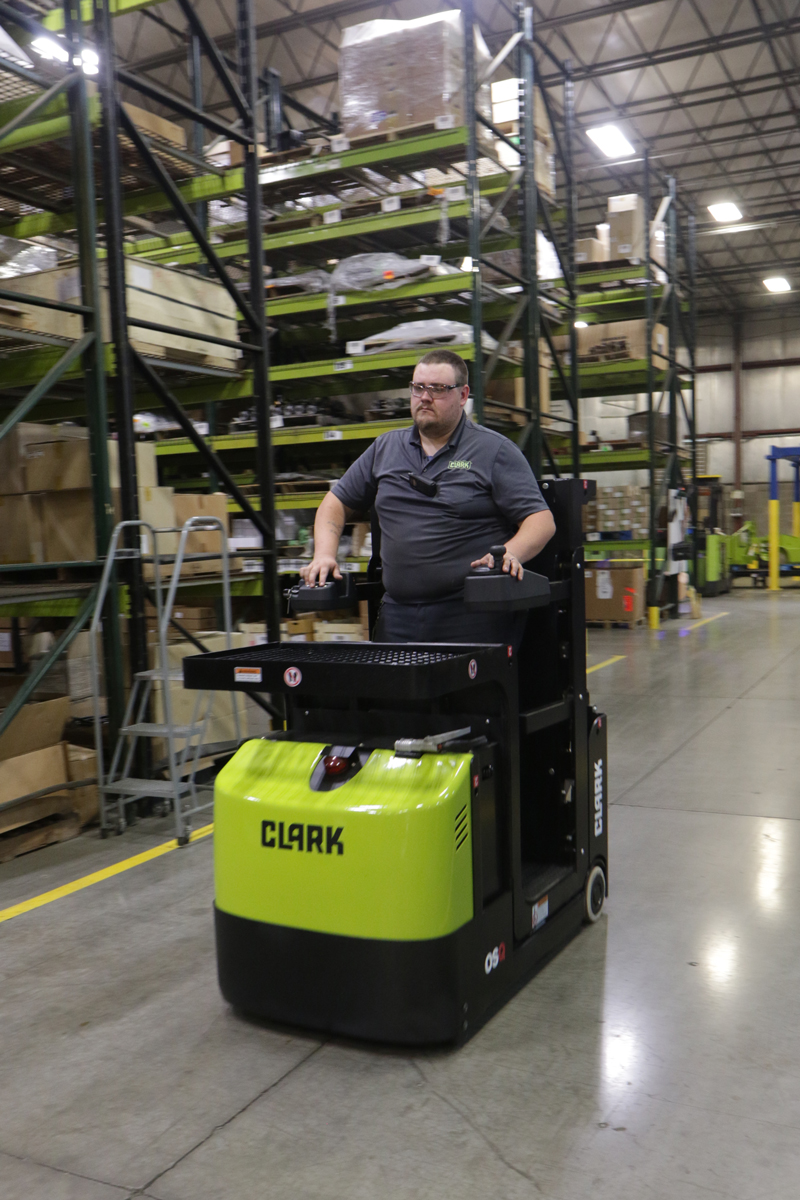The first Tructractor is built in Buchanan, Michigan by employees of the CLARK Equipment Company. The Tructractor was the world's first internal combustion-powered industrial truck. The Tructractor was originally configured with a flat bed or cargo box and was manually loaded and unloaded. It was used to haul materials between CLARK's various axle, drill and wheel departments. However, visitors to the plant were impressed with its practicality and asked CLARK to also build Tructractors for them. In 1918, eight Tructractors were built and in 1919 over 75 were manufactured.
History


The CLARK Tructractor Company is formed in Buchanan, Michigan as a division of the CLARK Equipment Company. Today's CLARK Material Handling Company is a direct descendant of the CLARK Tructractor Company. CLARK enters the export market as the first Tructractor is shipped to France.

The Truclift, an internal combustion-powered platform lift truck, is introduced. The Truclift was the world's first internal combustion lift truck that used hydraulics, not mechanical gears and linkage, to lift a load. Tructractors and Truclifts begin to be produced at a new CLARK plant in Battle Creek, Michigan.

The Duat tow tractor is introduced. The Duat was used to pull trailer loads of lumber, freight and industrial materials.

First shipment of a Duat with an optional tiering attachment. This modified Duat became the world's first internal combustion fork lift truck.

The Clarktor tow tractor is introduced. The Clarktor had drawbar pull ratings of 2000 and 2600 pounds. The Clarkat replaced the Duat, which had a drawbar pull rating of 1500 pounds. The Clarkat was used to pull trailers of freight and material and remained in production until 1982.

The Clarktor tow tractor is introduced. The Clarktor was used to pull airplanes and warehouse trailer trains. It was equipped with an electric self-starter, the first industrial truck or tractor to have this feature as standard equipment. The Clarktor remained in production until 1987.

The Tructier is introduced. The Tructier was the world's first internal combustion fork lift truck that used hydraulics, not chains and cables, to lift a load.

The Carloader, the world's first modern short-coupled internal combustion fork lift truck, is introduced. The Carloader was mass-produced from its introduction and was at one time imitated by many other fork lift truck manufacturers. It remained in production until 1964.

The Utilitruc is introduced. This heavy-duty internal combustion CLARK fork lift was used mainly in the metal fabrication and stevedoring industries and remained in production until 1964.

The Clipper is introduced. The Clipper became a standard for the internal combustion fork lift industry and at one time accounted for 50 percent of all sales in the 2000 pound capacity range. Like the Carloader and Utilitruc models, the Clipper was manufactured until 1964.

CLARK produces almost 90 percent of the military requirements for fork lift trucks and tow tractors. It was once said during WWII that there was not an air field under Allied control that did not have a CLARK fork lift truck or tow tractor. By the end of the war, the widespread use of CLARK lift trucks by the Allied Forces and war-related industries made "CLARK" and "fork lift" almost synonymous.

The first Electric Clippers, Carloaders, and Utilitrucs are introduced. However, because of wartime production demands for Carloader and Clarktors, they were not put into full production until 1945.

The Planeloader, CLARK's first pneumatic-tired fork lift truck, is introduced. It was designed principally for off-road operation at Allied air bases during WWII. War surplus Planeloaders were used by truck farmers, contractors and airlines. CLARK is awarded the Army-Navy "E" Award for outstanding war production. CLARK is the first lift truck manufacturer to put warning labels on lift trucks.

The Trucloader is introduced. It was intended for operations with limited elevator or floor load capabilities and was manufactured until 1967.

The Yardlift 40 is introduced. The Yardlift 40 was the beginning of the pneumatic Yardlift line. It was intended for inside and outside use in manufacturing and shipping facilities.

CLARK's innovative Dynatork Drive is introduced. The Dynatork was an electro-magnetic power transmission device between the internal combustion engine and the transmission. It replaced the dry friction clutch used on all fork lift trucks up until that time.

CLARK Equipment enters into manufacturing license agreement with Tutt-Bryant Limited of Sydney, Australia. This was the beginning of overseas production by CLARK.

CLARK Equipment enters into manufacturing license agreement with Schultz-Stinnes of Essen, Germany. By 1952, the licensee was re-named Ruhr Intrans Hubstapler and located in Mulheim when it started shipping Clark fork lift trucks into the European market.

The Hydrolift (internal combustion) and Electrolift (electric) pallet trucks are introduced. Later branded the Powrworker, the Electrolift was a powered walkie-type hand truck. It was available in pallet, platform, tug and forklift stacker type trucks.

The Hydratork fluid transmission is introduced. The Hydratork transmission was designed and built by CLARK and used a torque convertor to replace the dry friction clutch.

The Clarklift family line is introduced. The Clarklift was a complete line of internal combustion and electric powered fork lift trucks and was available in both cushion and pneumatic-tired versions. It eventually superseded the Carloader, Utilitruck and Clipper models. CLARK introduces the nested I-beam upright. This new upright design dramatically improved upright strength and load stability.

CLARK International, C.A. launches Equipamentos CLARK S.A. in Campinas, Brazil. This was CLARK's first production facility in South America.

CLARK is the first lift truck manufacturer to install load back rests and overhead guards as standard equipment on all of its trucks. Lift truck production begins at CLARK Equipments's St. Thomas, Ontario, Canada plant

The TW15/20 is introduced. The TW15/20 was the first electric three-wheel lift truck in the U.S. and became an industry standard. This highly maneuverable lift truck was used across multiple industries including shipping, warehousing and bottling. The TW15/20 evolved into the 24 volt TM10/15S in 1981. The TM10/15S in turn evolved into the 36 volt TM15/20 in 1986.

The C500 family line is introduced. The C500 line included internal combustion and electric trucks and was available with both cushion and pneumatic tires. Clark fork lifts in the C500 line ranged from 2000 pound capacity models for warehousing use to large 80,000 pound capacity models for steel fabrication. It eventually replaced the Clarklift model line.

CLARK offers the industry's first dual voltage electric trucks. These trucks provided performance options based on the demands of the customer's application.

CLARK's Georgetown, Kentucky plant begins production of sit down, narrow aisle stand-up & Powrworker electric lift trucks.

CLARK builds its 500,000th truck, a C500-50 internal combustion four wheel fork lift truck. Donated to Western Michigan University in 1977, where the truck was in service.

The ECA17-30 & EPA 20-30 four wheel electric trucks are introduced. They represented a major advance in CLARK electric lift truck design and ergonomics through improved reliability, productivity and operator comfort. The ECA model evolved into the ECS17-30 in 1987, which in turn evolved into the ECG20-32 in 1996.

The CLARK safety seat retrofit program is launched. CLARK's pioneering operator restraint system was offered free of charge to existing CLARK fork lift truck customers. The patent for this safety innovation was offered to all lift truck manufacturers, royalty-free.

The GCS/GPS "System" model trucks are introduced. The System Truck concept enabled customers to match their fork lift trucks to their applications through a selection of engines, axles and transmissions.

CLARK is the first lift truck manufacturer to provide the "Employer's Guide to Material Handling Safety" on every truck delivered.

CLARK is the first lift truck manufacturer to offer a factory-installed compressed natural gas (CNG) fuel option. The benefits of CNG include low emissions and cost.

The Genesis model line of four wheel internal combustion cushion and pneumatic-tire fork lifts is introduced. The Genesis featured a rubber isolated operator cell to improve operator comfort and set new industry standards for productivity and reliability.

The one-millionth CLARK truck is produced.

CLARK Material Handling Company acquires the Samsung Fork Lift Company of Korea. As CLARK Material Handling Asia, this facility designs and manufactures Clark lift trucks for the global market.

The CLARK M-Series model family, designed and manufactured by CLARK Material Handling Asia, is introduced to the lift truck market. The M-Series models extends and supplements CLARK's global product line-up.

CLARK Aftermarket Parts Depot in Louisville, Kentucky, is opened. This large parts facility has state-of-the-art pick systems and is strategically located to allow same day shipping to Clark's dealer network.

The CLARK Gen2 Series is introduced to the global lift truck market. The Gen2 is available in capacities of 4000 to 6500 pounds and with either cushion or pneumatic tires. Designed and manufactured by Clark Material Handling Asia, the Gen2 continues Clark's reputation for building reliable and hard-working lift trucks.

The EPX20/30 Series electric lift truck is released for applications that require pneumatic tires.

Young An Hat Company of Korea acquires CLARK Material Handling Company and CLARK Material Handling Asia.

CLARK Material Handling Company (CMHC) opens its new North American headquarters in Lexington, Kentucky.

The TMX12-25 and ECX20-32 sit-down electric riders with new 100% AC technology are introduced. These trucks excel in manufacturing, warehousing, bottling and shipping & receiving applications. The TMX12-25 and ECX20-32 AC feature reduced maintenance and noise.

Production of stand-up electric fork lift trucks moves to the CLARK Material Handling Company facility in Lexington, Kentucky.

CLARK Material Handling Company, Ltd headquarters and factory opens in Qingdao, China. This facility manufactures a range of electric and internal combustion lift trucks.

The GEX20/30 electric lift truck is introduced. This 80 volt pneumatic-tired truck offers outstanding speed and performance. A zero turn radius steer axle provides unmatched maneuverability.

CLARK introduces the C60-80 heavy-duty four wheel lift trucks. This new truck is intended for yard applications in heavy manufacturing, building materials handling, stevedoring and warehousing.

CLARK Material Handling Company observed 100 years of innovation and industry leadership in the design and manufacture of internal combustion and electric forklifts. Along with the introduction of the new Ford 2.5L LPG 4-cylinder engine, a special “Centennial Edition” custom paint and decal package was standard on all C20/C35 lift trucks throughout 2017, commemorating 100 years.

CLARK introduced the GTS20-33 series truck. Quality designed for distribution, manufacturing and warehousing of all types.

CLARK introduced VPTO. Employees were given 16 hours of paid time off to make a difference in the community.

CLARK introduced the new S-SERIES forklift trucks, the latest advancement of its “heart of the line” family of internal combustion trucks.

2018 CLARK opens new Research and Development center including test laboratory and prototype build shop.

CLARK opens new factory in Vietnam.

CLARK introduces the OSQ the 24-volt AC Working Platform Vehicle.

CLARK introduces the HWXE/PWXE...The foundation of the CLARK Powrworker® line continues to set the standard for rugged dependability since its introduction as the industry's first hydraulically powered low-lift in 1920

CLARK expanded facilities at its North American corporate headquarters in Lexington, Kentucky by adding a third facility to the company's manufacturing operation.

2019 – CLARK opens its product certification course. This course is designed to validate and test out new products and test components.

CLARK is named "Best Place to Work" in Kentucky
